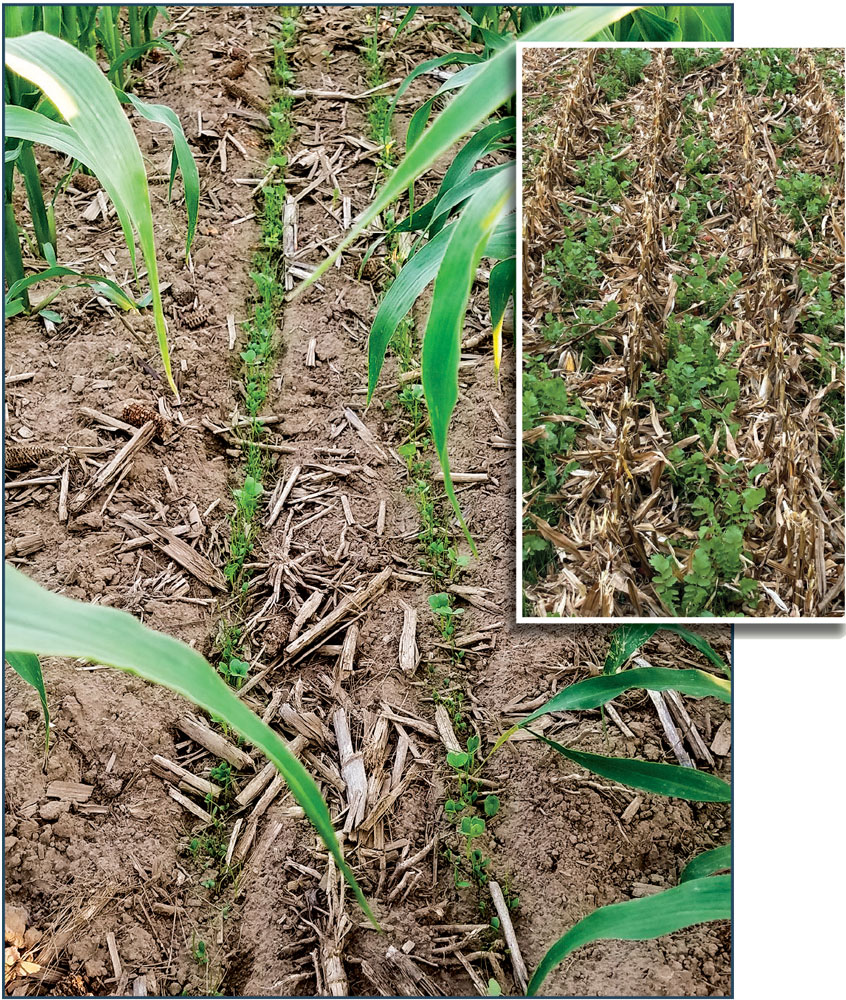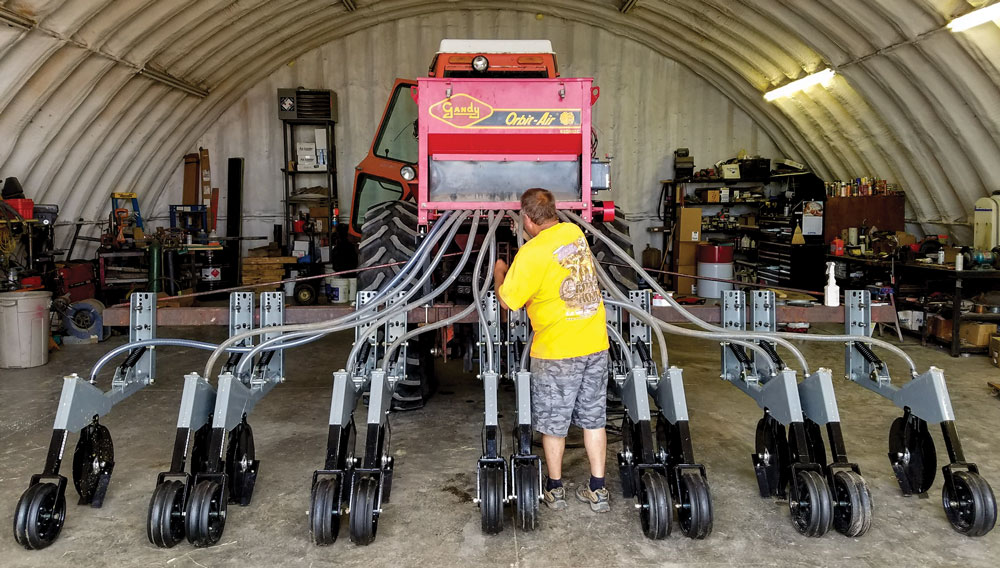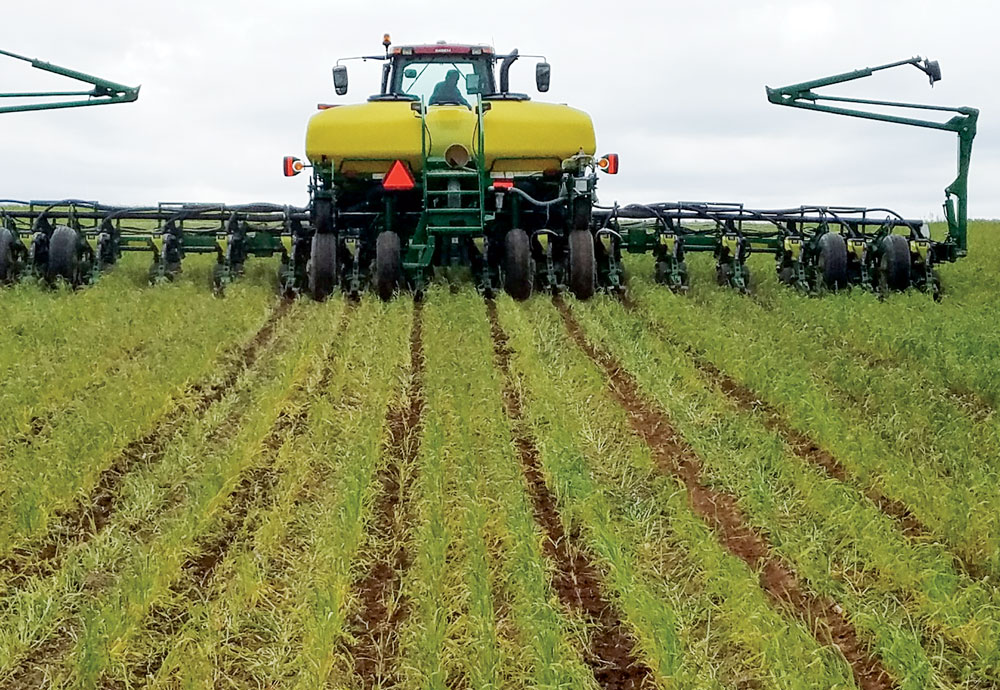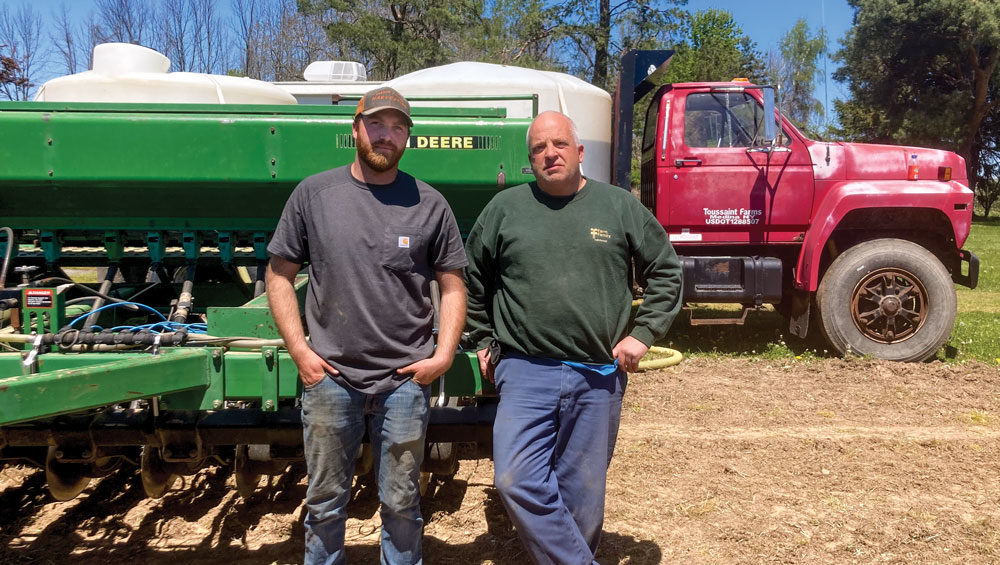Pictured Above: BUILDING SOIL. Jeff Toussaint (right) and his son Matt have taken to interseeding cover crops in their corn acres to improve the health of their soils and push up corn yields.
Water used to make itself nice and comfortable in many of our fields. Too comfortable. Rain and snowmelt would result in ponding that would delay field work or kill crops.
Cool, wet springs would turn fields into unplantable muddy messes. Tillage begat more tillage, resulting in powdery soils that were vulnerable to crusting, especially in the heavy clay soils closer to our home farm.
My son, Matt, and I farm right up to the edge of Lake Ontario. Back when I was tilling, the sandy loam ground on some of our farms would work up nicely, but the closer we got to the heavy clay soils near home, the greater the battle to get crops planted. We tried many promising remedies, including an array of tillage strategies, but couldn’t get the yields we thought we should.
After listening to Ray Rawson at various events we moved to zone till, then no-till, and now we’re interseeding cover crops, double cropping and adding new crops to our rotations.
Check The Specs...
NAME: Jeff Toussaint
FARM: Toussaint Farms
LOCATION: Medina, N.Y.
YEARS NO-TILLING: 26
ACRES: 1,300 acres
CROPS: Corn, soybeans, wheat, snap beans, triticale
Soil performance has improved by leaps and bounds as have yields in many cases. We’re using technology to target areas in our fields in need of focused, catered improvement and identify areas in prime condition that we can push harder.
Cover Crop Two-Step
It takes a bit of fancy footwork to grow cover crops in our environment. Cloudy days outnumber sunny ones, adding more challenge to an already short growing season. Much like our springs, falls are also wet. The bulk of the corn crop is often harvested in November. This leaves essentially no time to establish a cover crop after corn harvest.
As such, our wheat acres provided the logical proving ground when we started looking at cover crops about 12 years ago. After wheat harvest, we would drill a multispecies mix that would be followed by corn the next spring.
After corn harvest, I would analyze the data comparing corn-on-corn to corn-on-soybeans to corn-on-cover crops. There was almost always an 8-10-bushel yield increase in corn seeded to acres that were previously in cover crops as compared to any other combination.
There was a significant benefit, not only to crop production, but to the stability of our soils. We wanted cover crops on more acres, but with half of our acres in corn every year, timing proved difficult. So, 6 years into our cover crop efforts, we decided to tackle interseeding.
Interseeding is an interesting concept to justify as a farmer. We spend all this money killing weeds, then go in and plant something that’s not the crop. The neighbors thought — and probably still think — we were nuts. I won’t argue their assessment, but we’ve never seen a yield drag with interseeded crops. In fact, we usually see the same 8-10-bushel corn yield benefit when we seed the cover crop mix following wheat.

TIME AND SPACE. Timing the interseeding of cover crops between V4 and V6 is the sweet spot for Jeff Toussaint. The cover crop has time to germinate and establish well enough to survive several months of shade while also not growing too robust to compete with corn at critical growth points. Spacing the covers 4 inches from each corn row also reduces competition and maximizes sunlight interception by the cover crop once corn starts to dry down.
The biggest driver for interseeding cover crops goes beyond immediate yield benefits. We’re dealing with a lot of old, highly weathered soils. We want to build them up for long-term improved soil function. We won’t make much progress on that goal just getting a cover crop on them every three seasons or so in a normal rotation.
Interseeding allows us to continue taking steps to improve soils little by little every year. It’s a slow process even with no-till, but now with cover crops we’re starting to finally see marginal increases in soil organic matter as shown by soil testing and are bringing life and structure back to the soil.
Finding The Path
Through years of experimentation, we’ve worked out an interseeding system that works fairly consistently. Timing is especially critical.
The interseeded crop must germinate and be well started before the corn rows shade over. Once established, it will survive under the canopy. It won’t grow much until the corn desiccates and the sunlight can get to it. Harvest clears the path for maximum light to reach the cover crop and then it takes off.
Sounds simple, but to get a crop to germinate, establish, survive a shaded growing season and then thrive, requires ironing out a few wrinkles. The first was using the right method for planting our interseeded cover crop.
Initially we used a spreader to broadcast triticale but found this resulted in a very patchy stand — the product of a double mistake of broadcasting and late planting. Now we like to interseed the cover crop when the corn is between V4 and V6. Seed too soon and it can compete with the corn crop. Plant too late and it doesn’t establish well enough before the row canopies.
NO-TILL TAKEAWAYS
- Grid sampling can reveal some surprising pH variances in your fields.
- Mixed cover crops established after wheat can produce a 8-10-bushel yield increase in corn.
- Some herbicides will reduce the effectiveness of glyphosate in a tank mix and should be avoided for use on annual ryegrass.
We had greater success when we decided to take a crack at building our own interseeder. We pulled an old 6-row cultivator toolbar out of the weeds to serve as the base. We fitted it with Hiniker interseeder units. I was in too big of a rush to wait for our ordered air seeder tank, so we borrowed a Gandy from a neighbor to get in the field that first year. I mounted it on the toolbar, plumbed it up and hit the field.
It was a simple setup — just a double disc opener with spring down pressure and a rubber closing wheel. We put two units on each row so two rows of cover crop spaced 4 inches apart could be seeded down the center of the 30-inch corn rows.
The seed is barely scratched in — we just make a slight “V” trench and cover it up. But that made a big difference in the success of our interseeded crop. Before, there would be dry knolls with nothing and valleys with excellent cover. By getting the seed in the soil just a little bit we now see consistent establishment across the field through varying conditions.
The Right Crop
As we perfected our planting method, we also dialed in our interseeded species. Experimentation revealed we had to find the most shade-tolerant species. As a result, annual ryegrass has become the cornerstone of our program. Usually, we add radishes or crimson clover, too.
Test plots on our farm revealed those three species to be the most shade tolerant and successful in our system.
Annual ryegrass is amazing for interseeding and as a cover crop. I never thought the roots pushed as deep as they did until I was installing tile. We found annual ryegrass roots 4 feet deep at the tile line.
Those roots are breaking through any hardpans and when the roots die, the corn or soybean roots follow those root paths to retrieve water and nutrients from deeper in the soil profile. It also lets water and air move through the soil more effectively and the decaying roots improve soil organic matter (SOM).
Through the combined use of tiling, cover crops and interseeding ryegrass, clover and radishes, we see far less ponding, and anytime we do get water collecting, it dissipates far faster than in more traditionally managed nearby fields. I think the cover crops help the water permeate to the tile, so they really work together.
When it comes to spraying annual ryegrass, spraying when it’s too cold is a no-go. It needs to be at least 50 degrees F and the plants need to be actively growing. It must also be terminated before it hits the joint stage. Past that point it becomes much more difficult to kill.
Usually, I terminate prior to planting in late April or early May. Glyphosate works well, but some herbicides will reduce the effectiveness of glyphosate in a tank mix. I’ve had good luck with Verdict as a tank mix ahead of corn and Prowl ahead of soybeans.
With Verdict I do a two-pass program using a ½ or 2/3 rate with glyphosate and 2,4-D in a pre-plant burndown, then glyphosate and a light rate of Yukon for a post-emergence cleanup. I don’t want the herbicides to hang around a long time because they’ll hurt my cover crop mix.
Mixing it Up
Adjusting what crops we grow and their maturities helps us get more cover crops on more acres, which has become a priority on our farm. Our rotation is corn-corn-soybeans-wheat. It’s a very tight window to get wheat in after soybeans, so we plant a short-season soybean variety to give us more time.
It may cost us a little in yield on the soybeans, but the benefit we earn from getting a multi-species cover crop in behind the wheat is well worth it. Plus, wheat has been a good crop for us. We do sell the straw for an added income (except from fields where we feel the extra organic matter is critical). I think we’ve done better on wheat than soybeans in the last few years.

DIY INTERSEEDER. An old cultivator toolbar made it to the field once more when Jeff Toussaint used it as the frame for his self-made interseeder with the help of his employee, Ken Johnson (pictured). Doubled up Hiniker row units feature a simple double-disc opener with spring down pressure and a rubber closing wheel to seed two rows of cover crops down the centers of 30-inch corn rows.
In 2020 we tried snap beans in our rotation in place of soybeans on some acres. They appealed to us as they are a 2-month crop, so they give us a little more breathing room to establish a cover crop or plant winter wheat.
The harvest practice is different for snap beans, which means some extra considerations. Brushes pull the beans off the plant and they go up a conveyor belt where a fan blows out leaves and the beans go into the tank.
No-till corn obviously leaves a lot of standing residue — residue that would be pulled into the combine with the snap beans at harvest causing a real mess. To clear the path, we ran a Case IH True-Tandem vertical tillage tool over the corn ground just prior to planting the snap beans to lay down the residue. I don’t like to do that, but it made the rotation possible.
I like the diversity, the short growing season and the profit potential. It rained the day we planted and never rained again until harvest, so our first crop was a bit of a disaster. However, I think there’s potential and we’re trying it again.
We’ve also grown red clover as a bonus crop. It’s seeded in August following wheat harvest and harvested as silage the following late May or early June. We can then no-till corn right into the stubble using a slightly shorter season corn. It serves as a cover crop and we can sell it, so it’s a win-win. Our neighbor needs the feed, so he even comes and does the chopping.
Matt tried some triticale after snap beans. He was able to plant in late August to early September after harvest and it was then chopped for haylage the following May and can then be planted to corn or soybeans. Just another good option.
Analyzing The Fields
We use plenty of technology on the farm. When we switched from zone-till to no-till, we bought a John Deere 1770 planter. We put the Martin Till system on it with row cleaners, spaded closing wheels and a drag chain. We swapped out the airbags for Ag Leader’s hydraulic down pressure for the faster adjustments we felt we needed with our variable soils.
We use an Ag Leader Integra display to monitor our system and manage our individual row shutoffs that are critical in our oddly shaped fields. A Deere 750NT drill is used to seed soybeans and wheat.

MELLOW WORK. Seeding soybeans into annual ryegrass is an easy task despite cloudy, wet spring days that plague planting. The cover crops helps manage moisture and provide a firm platform for the drill, making the field more accessible despite the weather.
We’ve experimented with the Cornell Adapt-N program to help pinpoint nitrogen (N) use. The program looks at field planting date, hybrid maturity, growing degree days, rainfall, previous crop and more to come up with the most efficient timing and rates of N. N application is an inexact science, but we’re trying to take some guesswork out of it.
We’ve started grid sampling and matching results with Climate FieldView for specific seeding and fertility recommendations. It’s a wonderful tool that lets us evaluate different management strategies such as seeding rates or fertilizer rates. It tracks the applications and gives us a better means for evaluation.
Our first grid sampling adventures showed us there was a wide variety in pH in our soils, from 5.6-6.8. The grids showing the low pH were a real shock and might not have shown up with a more random soil sampling. Now we’re targeting up to 2-ton lime applications to those areas that different soil samples might not have called for any application.
It’s all fascinating. I’m in my early 60s and have seen so much change in our farm, especially in the last 10-15 years. The combination of no-till, cover crops and technology are helping move us forward and I hope my son continues this path. I think we’re set up well to have a successful transition to the fifth generation to farm this ground.








Post a comment
Report Abusive Comment